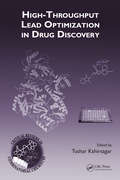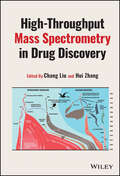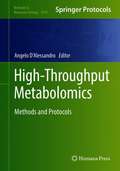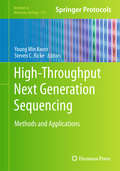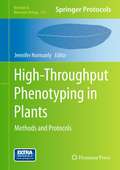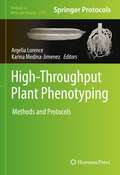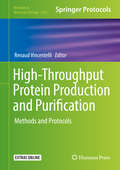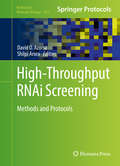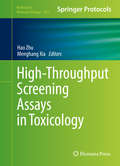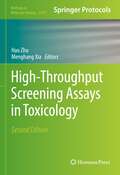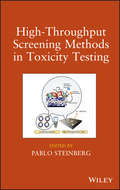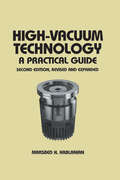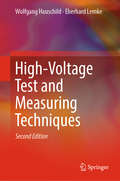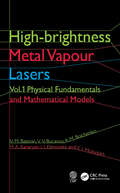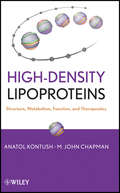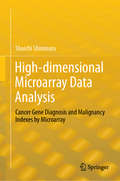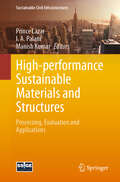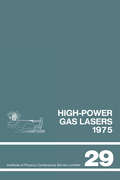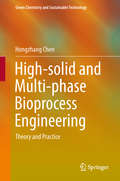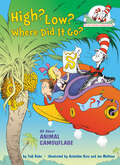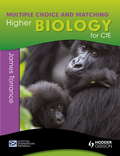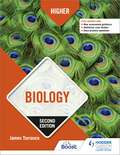- Table View
- List View
High-Throughput Lead Optimization in Drug Discovery (Critical Reviews in Combinatorial Chemistry)
by David C. Foyle Becky L. HooeyA Single Source on Parallel Synthesis for Lead OptimizationThe end of the previous millennium saw an explosion in the application of parallel synthesis techniques for making compounds for high-throughput screening. Over time, it became clear that more thought in the design phase of library development is necessary to generate high qualit
High-Throughput Mass Spectrometry in Drug Discovery
by Hui Zhang Chang LiuHigh-Throughput Mass Spectrometry in Drug Discovery Apply mass spectrometry to every phase of new drug discovery with this cutting-edge guide Mass spectrometry is a technique that identifies and characterizes compounds based on their mass — the fundamental molecular characteristic. It has become an invaluable analytical tool in various disciplines, industries, and research fields. It has become particularly central to new drug discovery and development, which broadly deploys mass spectrometry at every phase. The pharmaceutical industry has become one of the main drivers of technological development in mass spectrometry. High-Throughput Mass Spectrometry in Drug Discovery offers a comprehensive introduction to mass spectrometry and its applications in pharmaceutical discovery. It covers the foundational principles and science of mass spectrometry before moving to specific experimental methods and their applications at various stages of drug discovery. Its thorough treatment and detailed guidance make it an invaluable tool for pharmaceutical research and development. High-Throughput Mass Spectrometry in Drug Discovery readers will also find: Detailed analysis of techniques, including label-free screening, synthetic reaction optimization, and more An authorial team with extensive combined experience in research and industrial applications Technical strategies with the potential to accelerate quantitative bioanalysis in drug discovery High-Throughput Mass Spectrometry in Drug Discovery is essential for analytical, bioanalytical, and medicinal chemists working in the pharmaceutical industry and for any researchers and graduate students interested in drug discovery and development.
High-Throughput Metabolomics: Methods and Protocols (Methods in Molecular Biology #1978)
by Angelo D'AlessandroThis detailed volume focuses on recent technological, computational, and biostatistical advances in the field of high-throughput metabolomics. Chapters encompass methods, platforms, and analytical strategies for steady state measurements and metabolic flux analysis with stable isotope-labeled tracers, in biological matrices of clinical relevance and model organisms. Mass spectrometry-based or orthogonal methods are discussed, along with computational and statistical methods to address data sparsity in high-throughput metabolomics approaches. As a part of the highly successful Methods in Molecular Biology series, chapters include introductions to their respective topics, lists of the necessary materials and reagents, step-by-step, readily reproducible laboratory protocols, and tips on troubleshooting and avoiding known pitfalls. Authoritative and practical, High-Throughput Metabolomics: Methods and Protocols provides tools that can bring about the next generation of clinical biochemistry in a cost-effective, rigorous fashion, exponentially advancing our capacity to investigate nature while hastening the advent of personalized medicine.
High-Throughput Next Generation Sequencing
by Steven C. Ricke Young Min KwonDue to their novel concepts and extraordinary high-throughput sequencing capacity, the "next generation sequencing" methods allow scientists to grasp system-wide landscapes of the complex molecular events taking place in various biological systems, including microorganisms and microbial communities. These methods are now being recognized as essential tools for a more comprehensive and deeper understanding of the mechanisms underlying many biological processes. In High-Throughput Next Generation Sequencing: Methods and Applications, experts in the field explore the most recent advances in the applications of next generation sequencing technologies with an emphasis on microorganisms and their communities; however, the methods described in this book will also offer general applications relevant to the study of any living organisms. Written in the highly successful Methods in Molecular BiologyTM series format, chapters include introductions to their respective topics, lists of the necessary materials and reagents, step-by-step, readily reproducible laboratory protocols, and key tips on troubleshooting and avoiding known pitfalls. Comprehensive and cutting-edge, High-Throughput Next Generation Sequencing: Methods and Applications is an excellent collection of chapters to aid all scientists who wish to apply these innovative research tools to enhance their own pursuits in microbiology and also biology in general.
High-Throughput Phenotyping in Plants
by Jennifer NormanlyGenetic approaches to understanding plant growth and development have always benefitted from screens that are simple, quantitative and rapid. Visual screens and morphometric analysis have yielded a plethora of interesting mutants and traits that have provided insight into complex regulatory pathways, and yet many genes within any given plant genome remain undefined. The premise underlying High Throughput Phenotyping in Plants: Methods and Protocols is that the higher the resolution of the phenotype analysis the more likely that new genes and complex interactions will be revealed. The methods described in this volume can be generally classified as quantitative profiling of cellular components, ranging from ions to small molecule metabolites and nuclear DNA, or image capture that ranges in resolution from chlorophyll fluorescence from leaves and time-lapse images of seedling shoots and roots to individual plants within a population at a field site. Written in the successful Methods in Molecular BiologyTM series format, chapters include introductions to their respective topics, lists of the necessary materials and reagents, step-by-step, readily reproducible protocols, and notes on troubleshooting and avoiding known pitfalls. Authoritative and easily accessible, High Throughput Phenotyping in Plants: Methods and Protocols serves as an invaluable guide to plant researchers and all scientists who wish to better understand plant growth and development.
High-Throughput Plant Phenotyping: Methods and Protocols (Methods in Molecular Biology #2539)
by Argelia Lorence Karina Medina-JimenezThis volume looks at a collection of the latest techniques used to quantify the genome-by-environment-by-management (GxExM) interactions in a variety of model and plant crops. The chapters in this book are organized into five parts. Part One discusses high-throughput plant phenotyping (HTPP) protocols for plants growing under controlled conditions. Part Two present novel algorithms for extracting data from seed images, color analysis from fruits, and other digital readouts from 2D objects. Part Three covers molecular imaging protocols using PET and X-ray approaches, and Part Four presents a collection of HTPP techniques for crops growing under field conditions. The last part focuses on molecular analysis, metabolomics, network analysis, and statistical methods for the quantitative genetic analysis of HTP data. Written in the highly successful Methods in Molecular Biology series format, chapters include introductions to their respective topics, lists of the necessary materials and reagents, step-by-step, readily reproducible laboratory protocols, and tips on troubleshooting and avoiding known pitfalls. Cutting-edge and practical, High-Throughput Plant Phenotyping: Review and Protocols is a valuable resource for both novice and expert researchers looking to learn more about this important field.Chapter 21 is available open access under a Creative Commons Attribution 4.0 International License via link.springer.com.
High-Throughput Protein Production and Purification: Methods and Protocols (Methods in Molecular Biology #2025)
by Renaud VincentelliThis book compiles key protocols instrumental to the study of high-throughput protein production and purification which have been refined and simplified over the years and are now ready to be transferred to any laboratory. Beginning with a section covering general procedures for high-throughput protein production, the volume continues with high-throughput protocols adapted to the production of specific protein families, as well as an extensive section on protocols combining high-throughput protein production and their micro-characterization. Written for the highly successful Methods in Molecular Biology series, chapters in this book include introductions to their respective topics, lists of the necessary materials and reagents, step-by-step, readily reproducible laboratory protocols, and tips on troubleshooting and avoiding known pitfalls. Authoritative and practical, High-Throughput Protein Production and Purification: Methods and Protocols serves biochemists ranging from engineers, PhD students and post-doctoral fellows, to the heads of protein expression facilities and researchers, in pursuing this vital area of study.
High-Throughput RNAi Screening
by David O. Azorsa Shilpi AroraHigh-throughput RNAi screening remains one of the most widely used technologies to perform target identification and validation studies in an unbiased manner. These assays are equally important for research and development across academic, biotech, and pharmaceutical industries. The success of these screening efforts is dependent on robust methodologies to perform these screens. In "High-Throughput RNAi Screening: Methods and Protocols, " expert researchers in the field share protocols and methods for performing high-throughput RNAi (HT-RNAi) screens. These include the use of various RNAi platforms and delivery methods in mammalian and non-mammalian systems, whole organism and cell models, and various applications, such as drug sensitizer identification. Finally, the book examines the latest advancements in the fields of assay development, library screening, data analysis, and hit selection. Written in the highly successful "Methods in Molecular Biology "series format, chapters include introductions to their respective topics, lists of the necessary materials and reagents, step-by-step, readily reproducible laboratory protocols, and tips on troubleshooting and avoiding known pitfalls. Cutting-edge and thorough, "High-Throughput RNAi Screening: Methods and Protocols "provides a comprehensive source of protocols and other necessary information to make robust and successful assays possible for all who wish to apply HT-RNAi in their research.
High-Throughput Screening Assays in Toxicology
by Hao Zhu Menghang XiaThis book focuses on recently developed High Throughput Screening (HTS) assay protocols, many involved in the ToxCast and/or Tox21 initiatives, and the relevant HTS data analysis techniques. Divided into three sections, in vitro assays, in vivo assays, and computational techniques to analyze HTS data are all examined. Written for the highly successful "Methods in Molecular Biology" series, most chapters include introductions to their respective topics, lists of the necessary materials and reagents, step-by-step, readily reproducible laboratory protocols, and tips on troubleshooting and avoiding known pitfalls. Authoritative and practical, "High Throughput Screening Assays in Toxicology" serves as a valuable reference resource for translating new HTS techniques into standardized chemical toxicity assessment tools in order to advance modern toxicology research to a new era where HTS techniques can partially replace the prevailing animal models.
High-Throughput Screening Assays in Toxicology (Methods in Molecular Biology #2474)
by Hao Zhu Menghang XiaThis second edition volume expands on the previous edition by exploring the latest advancements in high throughput screening (HTS) in toxicity studies by using in vitro, ex vivo, and in vivo models. This volume also covers the application of artificial intelligence (AI) and data science to curate, manage, and use HTS data. Written in the highly successful Methods in Molecular Biology series format, chapters include introductions to their respective topics, lists of the necessary materials and reagents, step-by-step, readily reproducible laboratory protocols, and tips on troubleshooting and avoiding known pitfalls. Cutting-edge and thorough, High Throughput Screening Assays in Modern Toxicology, Second Edition is a valuable resource for scientists pursuing chemical toxicology research. This book will aid scientists and researchers in translating new HTS techniques into standardized chemical toxicology assessment tools that can refine, reduce, and replace animal testing.
High-Throughput Screening Methods in Toxicity Testing
by Pablo SteinbergExplores the benefits and limitations of the latest high-throughput screening methods With its expert coverage of high-throughput in vitro screening methods for toxicity testing, this book makes it possible for researchers to accelerate and streamline the evaluation and risk assessment of chemicals and drugs for toxicity. Moreover, it enables them to comply with the latest standards set forth by the U.S. National Research Council's "Toxicity Testing in the 21st Century: A Vision and Strategy" and the E.U.'s REACH legislation. Readers will discover a variety of state-of-the-science, high-throughput screening methods presented by a group of leading authorities in toxicology and toxicity testing. High-Throughput Screening Methods in Toxicity Testing is divided into five parts: General aspects, including predicting the toxicity potential of chemicals and drugs via high-throughput bioactivity profiling Assessing different cytotoxicity endpoints Assessing DNA damage and carcinogenesis Assessing reproductive toxicity, cardiotoxicity, and haematotoxicity Assessing drug metabolism and receptor-related toxicity Each chapter describes method principles and includes detailed information about data generation, data analysis, and applications in risk assessment. The authors not only enumerate the advantages of each high-throughput method over comparable conventional methods, but also point out the high-throughput method's limitations and potential pitfalls. In addition, the authors describe current research efforts to make high-throughput toxicity screening even more cost effective and streamlined. Throughout the book, readers will find plenty of figures and illustrations to help them understand and perform the latest high-throughput toxicity screening methods. This book is ideal for toxicologists and other researchers who need to implement high-throughput screening methods for toxicity testing in their laboratories as well as for researchers who need to evaluate the data generated by these methods.
High-Vacuum Technology: A Practical Guide, Second Edition
by Marsbed H. HablanianOffering a basic understanding of each important topic in vacuum science and technology, this book concentrates on pumping issues, emphasizes the behavior of vacuum pumps and vacuum systems, and explains the relationships between pumps, instrumentation and high-vacuum system performance. The book delineates the technical and theoretical aspects of the subject without getting in too deep. It leads readers through the subtleties of vacuum technology without using a dissertation on mathematics to get them there. An interesting blend of easy-to-understand technician-level information combined with engineering data and formulae, the book provides a non-analytical introduction to high vacuum technology.
High-Voltage Test and Measuring Techniques
by Wolfgang Hauschild Eberhard LemkeThe new edition of this book incorporates the recent remarkable changes in electric power generation, transmission and distribution. The consequences of the latest development to High Voltage (HV) test and measuring techniques result in new chapters on Partial Discharge measurements, Measurements of Dielectric Properties, and some new thoughts on the Shannon Theorem and Impuls current measurements. This standard reference of the international high-voltage community combines high voltage engineering with HV testing techniques and HV measuring methods. Based on long-term experience gained by the authors the book reflects the state of the art as well as the future trends in testing and diagnostics of HV equipment. It ensures a reliable generation, transmission and distribution of electrical energy. The book is intended not only for experts but also for students in electrical engineering and high-voltage engineering.
High-brightness Metal Vapour Lasers: Volume I: Physical Fundamentals and Mathematical Models
by M. A. Kazaryan V. M. Batenin V. V. Buchanov A. M. Boichenko I. I. Klimovskii E. I. MolodykhHigh brightness metal vapor lasers have become the most bright and powerful in the visible spectral range among all existing laser types, resulting in numerous applications ranging from purely fundamental research to practical application in large-scale commercial problems such as isotope selection. This book presents a full series of fundamental problems on the development of physical fundamentals and mathematical models for practical realization of a high-power laser radiation on self-contained transitions in metal atoms. It is the first fundamental review on physics and the technique of high-brightness metal vapor lasers.
High-density lipoproteins
by Anatol Kontush M. John Chapman Alexander MarienkoA complete guide to the role of high-density lipoproteins (HDL) in new and emerging therapies With high-density lipoproteins (HDL) playing an increasing role in cardiovascular disease prevention, there is a growing need for an in-depth look at HDL and its clinical value. This book summarizes the current state of knowledge in the field, providing for the first time a comprehensive, systematic, stylistically coherent, and up-to-date review of the composition, structure, heterogeneity, metabolism, epidemiology, genetics, and function of HDL. Divided into three main parts, High-Density Lipoproteins first examines normal HDL particles, then describes defective HDL, and finally addresses the therapeutic normalization of subnormal levels and defective biological activities of this lipoprotein class. The book highlights the functional properties of HDL, which are relevant to the pathophysiology of atherosclerosis and thrombosis, and discusses the compositional and metabolic heterogeneity of HDL particles. Readers will come away with a clear understanding of the role of HDL in biological processes, the potential value of functional HDL as a therapeutic target, and how current and emerging therapies are poised to influence the treatment of heart disease in the future.
High-dimensional Microarray Data Analysis: Cancer Gene Diagnosis and Malignancy Indexes by Microarray
by Shuichi ShinmuraThis book shows how to decompose high-dimensional microarrays into small subspaces (Small Matryoshkas, SMs), statistically analyze them, and perform cancer gene diagnosis. The information is useful for genetic experts, anyone who analyzes genetic data, and students to use as practical textbooks.Discriminant analysis is the best approach for microarray consisting of normal and cancer classes. Microarrays are linearly separable data (LSD, Fact 3). However, because most linear discriminant function (LDF) cannot discriminate LSD theoretically and error rates are high, no one had discovered Fact 3 until now. Hard-margin SVM (H-SVM) and Revised IP-OLDF (RIP) can find Fact3 easily. LSD has the Matryoshka structure and is easily decomposed into many SMs (Fact 4). Because all SMs are small samples and LSD, statistical methods analyze SMs easily. However, useful results cannot be obtained. On the other hand, H-SVM and RIP can discriminate two classes in SM entirely. RatioSV is the ratio of SV distance and discriminant range. The maximum RatioSVs of six microarrays is over 11.67%. This fact shows that SV separates two classes by window width (11.67%). Such easy discrimination has been unresolved since 1970. The reason is revealed by facts presented here, so this book can be read and enjoyed like a mystery novel. Many studies point out that it is difficult to separate signal and noise in a high-dimensional gene space. However, the definition of the signal is not clear. Convincing evidence is presented that LSD is a signal. Statistical analysis of the genes contained in the SM cannot provide useful information, but it shows that the discriminant score (DS) discriminated by RIP or H-SVM is easily LSD. For example, the Alon microarray has 2,000 genes which can be divided into 66 SMs. If 66 DSs are used as variables, the result is a 66-dimensional data. These signal data can be analyzed to find malignancy indicators by principal component analysis and cluster analysis.
High-performance Sustainable Materials and Structures: Processing, Evaluation and Applications (Sustainable Civil Infrastructures)
by Manish Kumar I. A. Palani Prince LazarThis book underscores the idea of harnessing the sustainable designs and materials in nature and integrating them into the field of engineering to design innovative materials and structures with multifunctional properties targeting defense, automotive, aerospace, electronics, nuclear, healthcare, energy, sports, packaging, etc. to offer improved safety, reliability, performance, durability, sustainability, and functionality. The concept of sustainability involves the understanding of how nature has evolved solutions to various challenges over millions of years and applying these principles to design innovative materials and structures with multifunctional properties. This book provides a thorough examination of the methods and techniques used in developing sustainable materials and structures, highlighting their potential for multifunctional applications. The book delves into the expansion of our understanding in this field, which is accompanied by novel synthesis and processing methods. These methods and techniques incorporate sustainable strategies, to create innovative materials and systems to offer a wide range of properties and functions, making them highly attractive for various applications in different fields of advanced technology. In addition, these materials and structures can be tailored to have specific properties and functions, such as self-healing capabilities, high strength-to-weight ratios, and enhanced energy absorption which are the prime requirements for the researchers looking for lightweight materials and structures.
High-power gas lasers, 1975: Lectures given at a summer school organized by the International College of Applied Physics, on the physics and technology
by E R PikeThis book presents lectures and seminars given at a Summer School, organized by the International College of Applied Physics, on the physics and technology and the industrial applications of high-power gas lasers.
High-solid and Multi-phase Bioprocess Engineering: Theory And Practice (Green Chemistry and Sustainable Technology)
by Hongzhang ChenThis book provides a comprehensive description of theories and applications of high-solid and multi-phase bioprocess engineering, which is considered as an important way to address the challenges of "high energy consumption, high pollution and high emissions" in bio-industry. It starts from specifying the solid-phase matrix properties that contribute to a series of “solid effects” on bioprocess, including mass transfer restrictions in porous media, water binding effects, rheological changes. Then it proposes the new principles of periodic intensification which combines the normal force and physiologic characteristics of microorganism for the bioprocess optimization and scale-up. Further breakthroughs in key periodic intensification techniques such as periodic peristalsis and gas pressure pulsation are described in detail which provide an industrialization platform and lay the foundation for high-solid and multi-phase bioprocess engineering. This book offers an excellent reference and guide for scientists and engineers engaged in the research on both the theoretical and practical aspects of high-solid and multi-phase bioprocess.
High? Low? Where Did It Go? All About Animal Camouflage: All About Animal Camouflage (The Cat in the Hat's Learning Library)
by Tish RabeLaugh and learn with fun facts about how animals camouflage by disguising, mimicking, concealing, and more—all told in Dr. Seuss&’s beloved rhyming style and starring the Cat in the Hat! &“I&’m the Cat in the Hat. Come and travel with me to find animals that are not easy to see.&” The Cat in the Hat&’s Learning Library series combines beloved characters, engaging rhymes, and Seussian illustrations to introduce children to non-fiction topics from the real world! Join the Cat in the Hat as he visits with animals who use camouflage to help survive—including: some who change color to blend insome who disguise themselves as things they are notsome who mimic animals that are dangerous, bad tasting, or poisonousand much more!Perfect for story time and for the youngest readers, High? Low? Where Did It Go? All About Animal Camouflage also includes an index, glossary, and suggestions for further learning. Look for more books in the Cat in the Hat&’s Learning Library series!Is a Camel a Mammal? All About MammalsThe 100 Hats of the Cat in the Hat: A Celebration of the 100th Day of SchoolA Great Day for Pup: All About Wild BabiesWould You Rather Be a Pollywog? All About Pond LifeHappy Pi Day to You! All About Measuring CirclesI Can Name 50 Trees Today! All About TreesFine Feathered Friends: All About BirdsMy, Oh My--A Butterfly! All About ButterfliesOh Say Can You Seed? All About Flowering PlantsInside Your Outside! All About the Human BodyIce is Nice! All About the North and South Poles
Higher Biology for CfE: Multiple Choice and Matching
by James Simms Clare Marsh Caroline StevensonThe perfect practice book for multiple choice and matching exercises that make up 20% of the final CfE Higher exam paper. This book offers ideal material for either classroom or homework activities, and allows students to construct a glossary of terms essential to the course, while banks of multiple choice questions enable them to practise extensivelty for the examination.
Higher Biology, Second Edition
by James Simms Clare Marsh Caroline Stevenson James Fullarton James TorranceExam Board: SQALevel: HigherSubject: BiologyFirst Teaching: August 2018First Exam: June 2019Ensure that students are prepared for every aspect of Higher Biology with the new edition of this popular textbook from James Torrance and his renowned author team, completely updated for the 2018 changes to the SQA Higher Biology syllabus.- Suggested learning activities throughout help to develop students' knowledge and skills including all new case studies, research topics and investigations- Testing your knowledge questions at the end of each chapter provide opportunities to continually assess Knowledge and Understanding, and are particularly useful for homework tasks- 'What you should know' summaries of key facts and concepts provide an excellent source of material for consolidation and revision prior to the SQA examination.- 'Applying Your Knowledge and Skills' sections at the end of each section have been substantially extended to give students extra practice in exam questions and foster the development of Skills of Scientific Experimentation, Investigation and Enquiry
Higher Biology, Second Edition
by James Simms Clare Marsh Caroline Stevenson James Fullarton James TorranceExam Board: SQALevel: HigherSubject: BiologyFirst Teaching: August 2018First Exam: June 2019Ensure that students are prepared for every aspect of Higher Biology with the new edition of this popular textbook from James Torrance and his renowned author team, completely updated for the 2018 changes to the SQA Higher Biology syllabus.- Suggested learning activities throughout help to develop students' knowledge and skills including all new case studies, research topics and investigations- Testing your knowledge questions at the end of each chapter provide opportunities to continually assess Knowledge and Understanding, and are particularly useful for homework tasks- 'What you should know' summaries of key facts and concepts provide an excellent source of material for consolidation and revision prior to the SQA examination.- 'Applying Your Knowledge and Skills' sections at the end of each section have been substantially extended to give students extra practice in exam questions and foster the development of Skills of Scientific Experimentation, Investigation and Enquiry
Higher Biology: Practice Papers for SQA Exams
by Graham Moffat Billy DicksonPractise for your SQA exams with three specially-commissioned Hodder Gibson Practice Exam Papers.- Practise with model papers written and checked by experienced markers and examiners- Get extra advice with specially-written study-skills guidance sections- Gain vital extra marks and avoid common mistakes with examiner tips
Higher Biology: Second Edition
by James Simms Clare Marsh Caroline StevensonExam Board: SQALevel: HigherSubject: BiologyFirst Teaching: August 2018First Exam: June 2019Ensure that students are prepared for every aspect of Higher Biology with the new edition of this popular textbook from James Torrance and his renowned author team, completely updated for the 2018 changes to the SQA Higher Biology syllabus.- Suggested learning activities throughout help to develop students' knowledge and skills including all new case studies, research topics and investigations- Testing your knowledge questions at the end of each chapter provide opportunities to continually assess Knowledge and Understanding, and are particularly useful for homework tasks- 'What you should know' summaries of key facts and concepts provide an excellent source of material for consolidation and revision prior to the SQA examination.- 'Applying Your Knowledge and Skills' sections at the end of each section have been substantially extended to give students extra practice in exam questions and foster the development of Skills of Scientific Experimentation, Investigation and Enquiry
